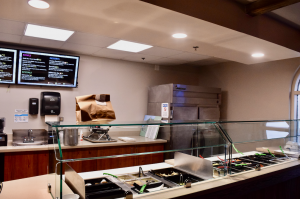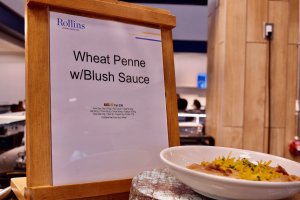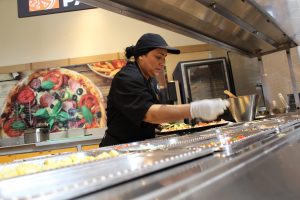Two weeks ago, The Sandspur featured an article about the discrepancy between the prices of items at the C-Store, 7-Eleven, and Walmart. As shown, C-Store prices are often double those found at Walmart. On top of the expensive C-Store prices, many students on campus have complained about the price of the food in the cafeteria. Themed meals often cost anywhere from $6 to $9 per plate, with additional items costing even more (a small salad is $2.39, a 6 oz. ladle of soup is $2.98, and most desserts are $3-$5 each).
Students living on campus will be here for approximately 112 days. They buy a meal plan that provides them with roughly $2057 to spend on food per semester. On average, that gives a student $20 a day for meals. Many students ponder the following question: is that enough?
Gerard Short, general manager of Dining Services, addressed this and other questions concerning the Rollins meal plan. First, he stated that the meal plan is only designed for 15 meals a week. They found that the majority of students go home or eat off campus on the weekends and leave for breaks, making 15 the average number of meals a student will eat on campus. But is it still possible to live off of this plan if you are on campus all the time? Short answers yes, on the basis that the student smartly budgets. There are cheaper alternatives like The Grille and Diane’s Cafe that are available to everyone.
Students also wonder: why does the Rollins plan differ from many other food plans across the country? Many other colleges have all-you-can- eat plans, including the University of Central Florida, whose seven-day-a-week, all-you-can eat plan costs only $1700, a significantly less amount of money dedicated to food when compared to the Rollins meal plan. Why is there such a difference in price?
Short provided two reasons for the declining balance plan: first, it builds community by allowing anyone in the cafeteria, not just people who can pay at the door; second, because of feedback from students. Dining Services has sent several focus groups to other colleges’ all-you-can eat programs and has received an overwhelmingly negative response from students.
Students have consistently stated that they prefer quality over quantity. The quality of food in the cafeteria is going to cost more money than other colleges because they do not have the same high quality that can be found at Rollins. Many other colleges do not have sushi, while Rollins also serves salmon and lobster bisque, both unheard of college foods.
Going back to last issue’s campus food debate, if quality costs more, then why is it that the C-Store products are more expensive compared to 7-Eleven or Wal-Mart when they all sell the exact same product? Why is there a price difference there?
Again, the answer is surprisingly simple and logical. While the C-Store may only be able to buy one crate of Ketchup from Heinz throughout a semester, Walmart can promise a few hundred million in the same amount of time. Walmart will get cut a deal, while the C-Store will not. Sodexo does have buying power over Pepsi and Coke, so the bottles of pop at the C-Store will always be set at a highly competitive price when compared to Walmart and other grocery stores.
In essence, Short takes pride in the dining program at Rollins and states that students “will not see [it matched] anywhere else in the state of Florida. Rollins is a service provider to the students.” If students want to see changes in the dining services on campus, students simply need to speak up. Dining services is listening.












Be First to Comment